英文summary写作范例
学术英语写作summary范文

学术英语写作summary范文全文共3篇示例,供读者参考篇1SummaryAcademic writing is a crucial skill for students and researchers at all levels. This summary aims to outline the key points to keep in mind when writing academically in English.Firstly, it is important to establish a clear and concise thesis statement at the beginning of your paper. This statement should clearly state the main argument or point you are trying to make, and should guide the reader through the rest of your paper.Secondly, it is essential to conduct thorough research on your topic before you start writing. This involves reading a variety of sources, including books, journal articles, and websites, to ensure that you have a good understanding of the current state of knowledge in your field.Once you have conducted your research, you should organize your ideas into a logical structure. This usually involves writing an outline, which can help you to see how your ideas relate to each other and ensure that your paper flows well.When it comes to actually writing your paper, it is important to use clear and concise language. Avoid using jargon or overly complicated language, as this can make it difficult for your reader to understand your ideas.Finally, it is crucial to properly cite your sources in your paper. This involves providing in-text citations whenever you use someone else's ideas, as well as a list of references at the end of your paper.In conclusion, academic writing in English requires careful planning, research, organization, and attention to detail. By following the tips outlined in this summary, you can improve your academic writing skills and produce papers that are clear, coherent, and well-structured.篇2Title: A Summary of Academic Writing in EnglishAcademic writing in English is a crucial skill that all scholars and researchers need to master in order to effectively communicate their ideas and findings to the academic community. In this summary, we will discuss the key elements of academic writing in English, including structure, style, and language.Structure is an essential aspect of academic writing in English. A well-structured academic paper should have a clear introduction, body, and conclusion. The introduction should provide background information on the topic, clearly state the research question or thesis, and outline the key points that will be discussed in the paper. The body of the paper should present the evidence and arguments that support the thesis, with each paragraph focusing on a single idea or point. The conclusion should summarize the main findings of the paper and restate the thesis in a new and interesting way.In terms of style, academic writing in English should be formal, objective, and concise. Avoid using colloquial language, contractions, and slang, and instead use formal language and academic vocabulary. Make sure to use clear and precise language to convey your ideas, and avoid unnecessary jargon or complex vocabulary that may confuse readers. It is also important to cite your sources properly and follow the specific citation style required by your discipline.Language is another important aspect of academic writing in English. Use the active voice whenever possible to make your writing more engaging and direct. Make sure to vary your sentence structure and avoid using the same words or phrasesrepeatedly. Pay attention to grammar, punctuation, and spelling, as errors in these areas can detract from the credibility of your work. Finally, use transitions and linking words to connect your ideas and make your writing flow more smoothly.In conclusion, mastering academic writing in English is essential for scholars and researchers who want to effectively communicate their ideas and findings to the academic community. By paying attention to structure, style, and language, you can improve the clarity and effectiveness of your writing and ensure that your work is taken seriously by your peers and colleagues.篇3Academic writing is an essential skill for students and scholars in various fields of study. Summary writing, in particular, is a useful technique that allows writers to condense and convey the main ideas of a text in a concise and coherent manner. In this paper, we will discuss the key components and strategies for effective academic summary writing.First and foremost, a good summary should accurately capture the main points of the original text. This involves identifying the key arguments, concepts, and evidencepresented by the author. It is important to focus on the most important ideas and omit any irrelevant details or examples. Additionally, the summary should maintain the original author's voice and tone while presenting the information in a clear and engaging manner.Another important aspect of academic summary writing is proper citation and attribution. When summarizing someone else's work, it is essential to give credit to the original author by including proper citations. This not only avoids plagiarism but also enhances the credibility and validity of the summary. In-text citations and a reference list should be included according to the appropriate citation style (e.g., APA, MLA, Chicago).Furthermore, effective summary writing requires careful attention to structure and organization. A well-structured summary typically includes an introduction that provides context and background information, a brief overview of the main points, and a conclusion that emphasizes the significance of the ideas presented. Using headings and subheadings can help to organize the information and guide the reader through the summary.In terms of language and style, academic summaries should be written in a formal and objective tone. Avoid using personalopinions or interpretations, and instead focus on presenting the author's arguments and findings objectively. Use clear and precise language, avoid jargon or overly technical terms, and ensure that the summary is easy to read and understand for a general audience.In conclusion, academic summary writing is an important skill that allows scholars to effectively communicate and engage with the ideas and research of others. By accurately condensing and presenting the main points of a text, providing proper citation and attribution, and organizing the information in a clear and structured manner, writers can create effective and impactful summaries that contribute to the academic discourse. Practice and refinement of these skills will help improve your academic writing abilities and enhance your ability to engage with the scholarly community.。
SUMMARY 格式及模板.
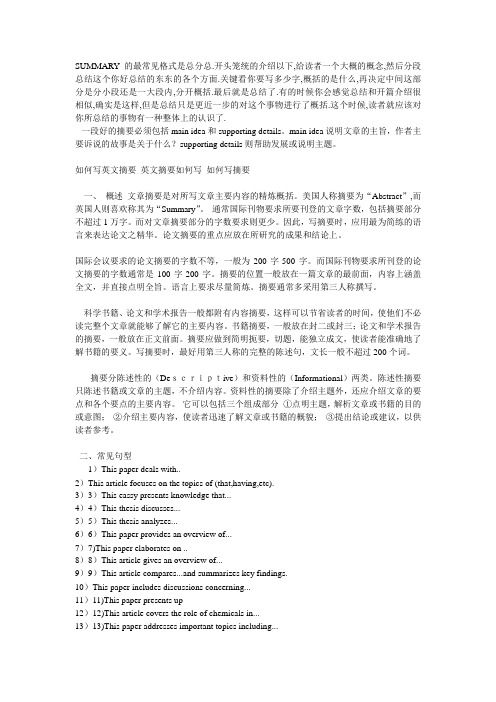
SUMMARY的最常见格式是总分总.开头笼统的介绍以下,给读者一个大概的概念,然后分段总结这个你好总结的东东的各个方面.关键看你要写多少字,概括的是什么,再决定中间这部分是分小段还是一大段内,分开概括.最后就是总结了.有的时候你会感觉总结和开篇介绍很相似,确实是这样,但是总结只是更近一步的对这个事物进行了概括.这个时候,读者就应该对你所总结的事物有一种整体上的认识了.一段好的摘要必须包括main idea和supporting details。
main idea说明文章的主旨,作者主要诉说的故事是关于什么?supporting details则帮助发展或说明主题。
如何写英文摘要英文摘要如何写如何写摘要一、概述文章摘要是对所写文章主要内容的精炼概括。
美国人称摘要为“Abstract”,而英国人则喜欢称其为“Summary”。
通常国际刊物要求所要刊登的文章字数,包括摘要部分不超过1万字。
而对文章摘要部分的字数要求则更少。
因此,写摘要时,应用最为简练的语言来表达论文之精华。
论文摘要的重点应放在所研究的成果和结论上。
国际会议要求的论文摘要的字数不等,一般为200字-500字。
而国际刊物要求所刊登的论文摘要的字数通常是100字-200字。
摘要的位置一般放在一篇文章的最前面,内容上涵盖全文,并直接点明全旨。
语言上要求尽量简炼。
摘要通常多采用第三人称撰写。
科学书籍、论文和学术报告一般都附有内容摘要,这样可以节省读者的时间,使他们不必读完整个文章就能够了解它的主要内容。
书籍摘要,一般放在封二或封三;论文和学术报告的摘要,一般放在正文前面。
摘要应做到简明扼要,切题,能独立成文,使读者能准确地了解书籍的要义。
写摘要时,最好用第三人称的完整的陈述句,文长一般不超过200个词。
摘要分陈述性的(Descriptive)和资料性的(Informational)两类。
陈述性摘要只陈述书籍或文章的主题,不介绍内容。
资料性的摘要除了介绍主题外,还应介绍文章的要点和各个要点的主要内容。
英语作文summary模板及句型
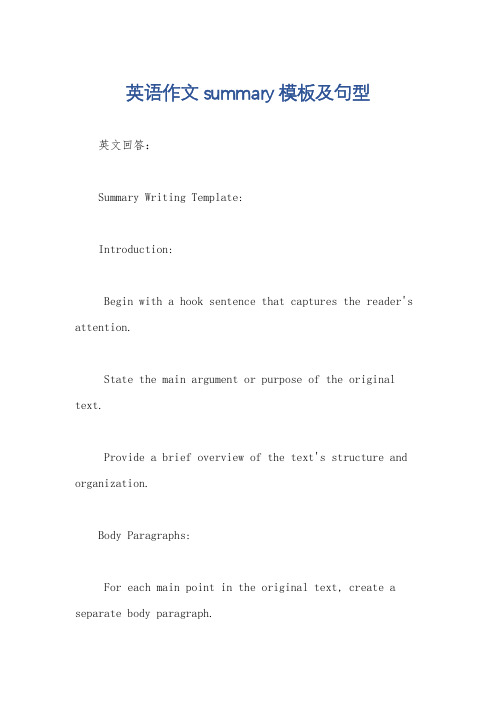
英语作文summary模板及句型英文回答:Summary Writing Template:Introduction:Begin with a hook sentence that captures the reader's attention.State the main argument or purpose of the original text.Provide a brief overview of the text's structure and organization.Body Paragraphs:For each main point in the original text, create a separate body paragraph.Start with a topic sentence that clearly states the main point.Support the topic sentence with evidence and analysis from the original text.Use specific examples, quotations, or paraphrases to demonstrate the author's arguments.Provide transitions between paragraphs to maintain coherence.Conclusion:Summarize the main points of the original text.Restate the main argument or purpose of the text.Conclude with a final thought or reflection on the significance of the original text.Phrases for Summarizing:To introduce the original text:The author argues that...The text examines...The central idea of the text is...To state main points:The first main point is...Another important point made by the author is...A key argument presented in the text is...To provide evidence:For instance, the author writes...As evidence, the text provides...The author illustrates this point with the example of...To conclude:In conclusion, the text argues that...The author's main point is...The text effectively demonstrates...中文回答:摘要写作模板:引言:以吸引读者注意力的主题句开头。
10篇英语summary范文
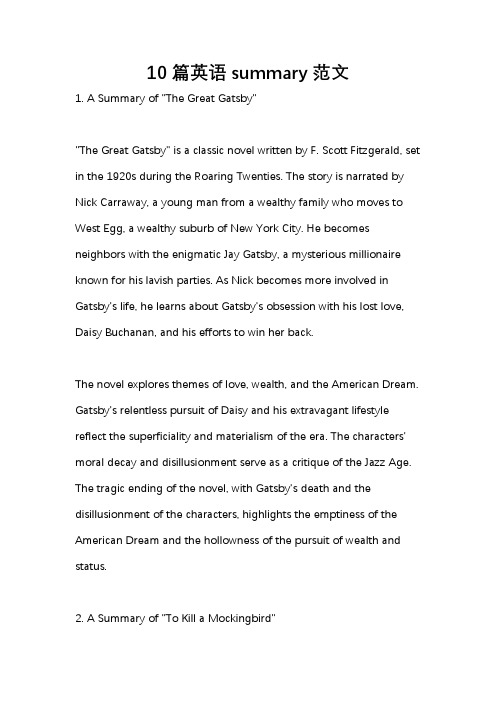
10篇英语summary范文1. A Summary of "The Great Gatsby""The Great Gatsby" is a classic novel written by F. Scott Fitzgerald, set in the 1920s during the Roaring Twenties. The story is narrated by Nick Carraway, a young man from a wealthy family who moves to West Egg, a wealthy suburb of New York City. He becomes neighbors with the enigmatic Jay Gatsby, a mysterious millionaire known for his lavish parties. As Nick becomes more involved in Gatsby's life, he learns about Gatsby's obsession with his lost love, Daisy Buchanan, and his efforts to win her back.The novel explores themes of love, wealth, and the American Dream. Gatsby's relentless pursuit of Daisy and his extravagant lifestyle reflect the superficiality and materialism of the era. The characters' moral decay and disillusionment serve as a critique of the Jazz Age. The tragic ending of the novel, with Gatsby's death and the disillusionment of the characters, highlights the emptiness of the American Dream and the hollowness of the pursuit of wealth and status.2. A Summary of "To Kill a Mockingbird""To Kill a Mockingbird" is a novel written by Harper Lee, set in the 1930s in the fictional town of Maycomb, Alabama. The story is narrated by Scout Finch, a young girl who grows up with her brother Jem and their father, Atticus Finch. The novel explores themes of racism, injustice, and morality through the trial of Tom Robinson, a black man falsely accused of raping a white woman.Atticus, a lawyer, defends Tom Robinson in court, despite facing backlash and prejudice from the townspeople. Through the trial, the novel exposes the deep-seated racism and prejudice in the town, as well as the courage and integrity of Atticus in standing up for what is right. The novel also addresses the loss of innocence and the coming-of-age of Scout and Jem as they witness the harsh realities of the world around them.3. A Summary of "1984""1984" is a dystopian novel written by George Orwell, set in a totalitarian society ruled by the Party and its leader, Big Brother. The story follows the protagonist, Winston Smith, as he rebels against the oppressive regime and seeks truth and freedom. The novel exploresthemes of surveillance, propaganda, and the power of language.In the world of "1984," the Party controls every aspect of people's lives, using surveillance and propaganda to maintain its grip on power. Winston, disillusioned with the Party's lies and oppression, begins a secret love affair with Julia, a fellow rebel. As they seek to defy the Party and find a sense of individuality and truth, they are eventually captured and tortured by the Thought Police.The novel serves as a warning against the dangers of totalitarianism and the erosion of individual freedom. It also highlights the manipulation of truth and language by those in power, as well as the resilience of the human spirit in the face of oppression.4. A Summary of "Pride and Prejudice""Pride and Prejudice" is a novel written by Jane Austen, set in 19th century England. The story follows the romantic entanglements of the Bennet sisters, particularly Elizabeth Bennet and Mr. Darcy. The novel explores themes of love, marriage, and social class.The main plot revolves around the developing relationship betweenElizabeth and Mr. Darcy, which is initially hindered by their pride and prejudice towards each other. As they navigate the obstacles of misunderstandings and societal expectations, they ultimately overcome their differences and find true love. The novel also delves into the lives of the other Bennet sisters and their pursuit of marriage and happiness.Through its witty social commentary and engaging characters, "Pride and Prejudice" offers a nuanced portrayal of the societal norms and expectations of the time. It critiques the superficiality and materialism of the upper class, while also celebrating the power of love and individual agency in shaping one's destiny.5. A Summary of "The Catcher in the Rye""The Catcher in the Rye" is a novel written by J.D. Salinger, narrated by the teenage protagonist, Holden Caulfield. The story follows Holden's experiences after being expelled from his prep school and his aimless wandering around New York City. The novel explores themes of adolescence, alienation, and the search for authenticity.Holden is disillusioned with the phoniness and hypocrisy of the adultworld, and he struggles to find his place in society. As he encounters various people and situations, he grapples with his own identity and the complexities of growing up. The novel also delves into the loss of innocence and the pain of Holden's past, as he grapples with the death of his younger brother, Allie."The Catcher in the Rye" is celebrated for its authentic portrayal of teenage angst and rebellion. It captures the universal experience of coming-of-age and the challenges of navigating the transition from adolescence to adulthood. Holden's candid and introspective voice resonates with readers, making the novel a timeless classic.6. A Summary of "The Old Man and the Sea""The Old Man and the Sea" is a novella written by Ernest Hemingway, set in Cuba. The story follows an aging fisherman, Santiago, as he embarks on a challenging fishing expedition in the Gulf Stream. The novella explores themes of perseverance, resilience, and the struggle against nature.Santiago, once a great fisherman, has fallen on hard times and struggles to catch fish. Despite his recent misfortune, he sets out ona journey to catch a giant marlin. The novella depicts his arduous battle with the marlin and the physical and emotional toll it takes on him. As he fights to bring the marlin back to shore, he faces numerous obstacles, including sharks that attack his catch."The Old Man and the Sea" is a timeless tale of human endurance and the indomitable spirit of man. Santiago's unwavering determination and courage in the face of adversity serve as a powerful metaphor for the human condition. The novella's poignant portrayal of the triumph of the human spirit has made it a classic in literature.7. A Summary of "Brave New World""Brave New World" is a dystopian novel written by Aldous Huxley, set in a futuristic society where technology and conditioning are used to control and manipulate people. The story follows the protagonist, Bernard Marx, as he rebels against the conformity and artificial happiness of the World State. The novel explores themes of individuality, freedom, and the dehumanizing effects of technology.In the World State, people are genetically engineered andconditioned to fit into predetermined social roles. They are kept docile and content through the use of pleasure-inducing drugs and mind control. Bernard, an outsider in this society, becomes disillusioned with the lack of genuine human connection and seeks to find meaning and authenticity in his life."Brave New World" serves as a cautionary tale about the dangers of a society driven by technology and consumerism. It raises thought-provoking questions about the nature of happiness and the price of conformity. The novel's exploration of the tension between individuality and societal control continues to resonate with readers today.8. A Summary of "The Scarlet Letter""The Scarlet Letter" is a novel written by Nathaniel Hawthorne, set in 17th century Puritan New England. The story follows Hester Prynne, a woman who is publicly shamed and ostracized for committing adultery and bearing a child out of wedlock. The novel explores themes of sin, guilt, and redemption.Hester is forced to wear a scarlet letter "A" as a mark of her shame,and she struggles to rebuild her life in the face of judgment and condemnation. The novel also delves into the inner turmoil of the Reverend Dimmesdale, who is secretly the father of Hester's child and grapples with his guilt and hypocrisy. The character of Pearl, Hester's daughter, serves as a symbol of both sin and innocence."The Scarlet Letter" is a powerful exploration of the human condition and the complexities of morality. It delves into the consequences of societal judgment and the search for redemption and forgiveness. The novel's timeless themes and rich symbolism continue to captivate readers and provoke thought and reflection.9. A Summary of "The Outsiders""The Outsiders" is a novel written by S.E. Hinton, set in the 1960s in Tulsa, Oklahoma. The story follows the rivalry between two groups of teenagers, the Greasers and the Socs, and the struggles of the protagonist, Ponyboy Curtis, to find his place in the world. The novel explores themes of class conflict, identity, and the bonds of friendship.Ponyboy and his friends, including his brothers Sodapop and Darry,navigate the challenges of growing up in a tough neighborhood and facing prejudice and violence from the Socs. The novel delves into the dynamics of the Greaser gang and their loyalty to each other, as well as the complexities of their relationships with the Socs. Through the characters' experiences, the novel offers a poignant portrayal of the impact of social class on individual identity and relationships."The Outsiders" is celebrated for its authentic portrayal of teenage life and the universal struggles of adolescence. It addresses the themes of friendship, loyalty, and the search for belonging, resonating with readers of all ages. The novel's enduring relevance and powerful storytelling have solidified its status as a classic in young adult literature.10. A Summary of "Animal Farm""Animal Farm" is a novella written by George Orwell, serving as a satirical allegory of the Russian Revolution and the rise of totalitarianism. The story is set on a farm where the animals, led by the pigs, revolt against the oppressive human farmer and establish their own society based on the principles of equality and freedom. The novella explores themes of power, corruption, and themanipulation of language.Initially, the animals' rebellion leads to a utopian society where all animals are equal and free. However, the pigs, led by Napoleon, gradually seize power and establish a dictatorship, exploiting and oppressing the other animals. The novella depicts the pigs' manipulation of the principles of Animalism and their betrayal of the original ideals of the revolution."Animal Farm" serves as a powerful critique of the dangers of totalitarianism and the corruption of power. It also highlights the manipulation of language and propaganda to control and deceive the masses. The novella's timeless themes and allegorical storytelling continue to resonate with readers, offering a compelling commentary on the nature of political power and human nature.。
(完整版)高考英语summary写作【终极版】.doc
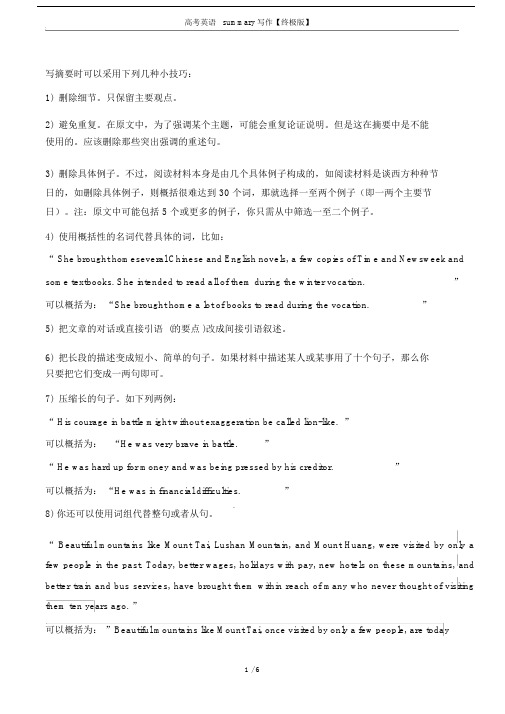
高考英语summary 写作【终极版】写摘要时可以采用下列几种小技巧:1)删除细节。
只保留主要观点。
2)避免重复。
在原文中,为了强调某个主题,可能会重复论证说明。
但是这在摘要中是不能使用的。
应该删除那些突出强调的重述句。
3)删除具体例子。
不过,阅读材料本身是由几个具体例子构成的,如阅读材料是谈西方种种节日的,如删除具体例子,则概括很难达到 30 个词,那就选择一至两个例子(即一两个主要节日)。
注:原文中可能包括 5 个或更多的例子,你只需从中筛选一至二个例子。
4)使用概括性的名词代替具体的词,比如:“ She brought homeseveral Chinese and English novels, a few copies of Time and Newsweek and some textbooks. She intended to read all of them during the winter vocation.”可以概括为:“She brought home a lot of books to read during the vocation.”5)把文章的对话或直接引语 (的要点 )改成间接引语叙述。
6)把长段的描述变成短小、简单的句子。
如果材料中描述某人或某事用了十个句子,那么你只要把它们变成一两句即可。
7)压缩长的句子。
如下列两例:“ His courage in battle might without exaggeration be called lion-like. ”可以概括为:“He was very brave in battle.”“ He was hard up for money and was being pressed by his creditor.”可以概括为:“He was in financial difficulties.”8) 你还可以使用词组代替整句或者从句。
研究生英语summary万能模板
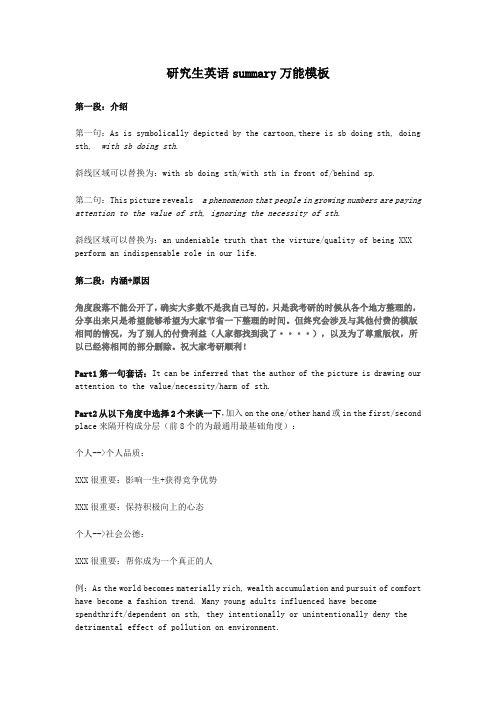
研究生英语summary万能模板第一段:介绍第一句:As is symbolically depicted by the cartoon,there is sb doing sth, doing sth, with sb doing sth.斜线区域可以替换为:with sb doing sth/with sth in front of/behind sp.第二句:This picture reveals a phenomenon that people in growing numbers are paying attention to the value of sth, ignoring the necessity of sth.斜线区域可以替换为:an undeniable truth that the virture/quality of being XXX perform an indispensable role in our life.第二段:内涵+原因角度段落不能公开了,确实大多数不是我自己写的,只是我考研的时候从各个地方整理的,分享出来只是希望能够希望为大家节省一下整理的时间。
但终究会涉及与其他付费的模版相同的情况,为了别人的付费利益(人家都找到我了····),以及为了尊重版权,所以已经将相同的部分删除。
祝大家考研顺利!Part1第一句套话:It can be inferred that the author of the picture is drawing our attention to the value/necessity/harm of sth.Part2从以下角度中选择2个来谈一下,加入on the one/other hand或in the first/second place来隔开构成分层(前8个的为最通用最基础角度):个人-->个人品质:XXX很重要:影响一生+获得竞争优势XXX很重要:保持积极向上的心态个人-->社会公德:XXX很重要:帮你成为一个真正的人例:As the world becomes materially rich, wealth accumulation and pursuit of comfort have become a fashion trend. Many young adults influenced have become spendthrift/dependent on sth, they intentionally or unintentionally deny the detrimental effect of pollution on environment.XXX很重要:随着物质丰富,人们忽视可XXX的影响第二段补充:如果发现第二段感觉字数不够,可以用以下“套话”嵌入增加字数。
英文summary写作范例Children Must be Taught to Tell Right from Wrong

Children Must be Taught to Tell Right from WrongWilliam KilpatrickMany of today’s young people have a difficult time seeing any moral dimension (道德层面) to their actions. There are a number of reasons why that’s true, but none more prominent than a failed system of education that eschews (回避) teaching children the traditional moral values that bind Americans together as a society and a culture. That failed approach, called “decision-making,” was introduced in schools 25 years ago. It tells children to decide for themselves what is right and what is wrong. It replaced “character education. (品格教育)” Character education didn’t ask children to reinvent the moral wheel(浪费时间重新发明早已存在的道德标准); instead, it encouraged them to practice habits of courage, justice and self-control.In the 1940s, when a character education approach prevailed, teachers worried about students chewing gum; today they worry about robbery and rape.Decision-making curriculums pose thorny (棘手的) ethical dilemmas to students, leaving them with the impression that all morality is problematic and that all questions of right and wrong are in dispute. Youngsters are forced to question values and virtues they’ve never acquired in the first place or upon which they have only a tenuous (薄弱的) hold. The assumption behind this method is that students will arrive at good moral conclusions if only they are given the chance. But the actual result is moral confusion.For example, a recent national study of 1,700 sixth- to ninth-graders revealed that a majority of boys considered rape to be acceptable under certain conditions. Astoundingly, many of the girls agreed.This kind of moral illiteracy is further encouraged by values-education (价值观教育) programs that are little more than courses in self-esteem (自尊). These programs are based on the questionable assumption that a child who feels good about himself or herself won’t want to do anything wrong. But it is just as reasonable to make an opposite assumption: namely, that a child who has uncritical self-regard will conclude that he or she can’t do anything bad.Such naive self-acceptance results in large part from the non-directive (无指导性的), non-judgmental (无是非观的), as-long-as-you-feel-comfortable-with-your-choices mentality (思想) that has pervaded (渗透) public education for the last two and one-half decades. Many of today’s drug education, sex education and values-education courses are based on the same 1960s philosophy that helped fuel the explosion in teen drug use and sexual activity in the first place.Meanwhile, while educators are still fiddling with (胡乱摆弄) outdated “feel-good” approaches, New York, Washington, and Los Angeles are burning. Youngsters are leaving school believing that matters of right and wrong are always merely subjective. If you pass a stranger on the street and decide to murder him because you need money—if it feels right—you go with that feeling. Clearly, murder is not taught in our schools, but such a conclusion—just about any conclusion—can be reached and justified using the decision-making method.It is time to consign (寄出) the fads (风尚) of “decision-making” and “non-judgmentalism” to the ash heap of failed policies, and return to a proved method. Character education provides a much more realistic approach to moral formation. It is built on an understanding that we learn morality not by debating it but by practicing it.Summary of “Children Must be Taught to Tell Right from Wrong”In his essay “Children Must be Taught to Tell Right from Wrong,” William Kilpatrick argues fervently that the “decision-making”approach to the moral education of American youth, which replaced “character education” 25 years ago, has prevented juveniles from behaving and thinking in accordance with the traditional moral principles that are fundamental to American society.According to Kilpatrick, decision-making methods instill in students a wrong belief that all norms of morality are subjective constructs with only relative truth in them and therefore can be interpreted flexibly and even questioned. This belief deprives them of the chance to secure solid moral standards and induces misconceptions about what should be clearly right or wrong.In parallel with this inadequacy of the “de cision-making” approach are the unexpected outcomes of those values-education programs focusing on students’ self-esteem that subscribe to the “non-judgmental” mindset dominating “decision-making” curriculums. Their mistaken assumption that feeling good warrants morality excuses students from criticizing and disciplining their own behaviors.Basing his conclusion on his analysis of the fundamental flaws of the decision-making approach, Kilpatrick finally proposes an immediate shift back to character education which he believes teaches morality more effectively by emphasizing practice instead of discussion.。
【精品作文】summary范文

emphasizing practice instead of discussion.
篇二:summary 范文
Original:
My neighbor's children love playing hide-and-seek as all children do, but no one imagine that a game they played last week would be reported in the local newspaper.
In the 1940s, when a character education approach prevailed, teachers worried about students chewing gum; today they worry about robbery and rape.
Decision-making curriculums pose thorny (棘手的) ethical dilemmas to students, leaving them with the impression that all morality is problematic and that all questions of right and wrong are in dispute. Youngsters are forced to question values and virtues they’ve never acquired in the first place or upon which they have only a tenuous (薄弱的) hold. The assumption behind this method is that students will arrive at good moral conclusions if only they are given the chance. But the actual result is moral confusion.
- 1、下载文档前请自行甄别文档内容的完整性,平台不提供额外的编辑、内容补充、找答案等附加服务。
- 2、"仅部分预览"的文档,不可在线预览部分如存在完整性等问题,可反馈申请退款(可完整预览的文档不适用该条件!)。
- 3、如文档侵犯您的权益,请联系客服反馈,我们会尽快为您处理(人工客服工作时间:9:00-18:30)。
ArticleChildren Must be Taught to Tell Right from WrongWilliam KilpatrickMany of today’s young people have a difficult time seeing any moral dimension (道德层面) to their actions. There are a number of reasons why that’s true, but none more prominent than a failed system of education that eschews (回避) teaching children the traditional moral values that bind Americans together as a society and a culture. That failed approach, called “decision-making,”was introduced in schools 25 years ago. It tells children to decide for themselves what is right and what is wrong. It replaced “character education. (品格教育)” Character education didn’t ask children to reinvent the moral wheel (浪费时间重新发明早已存在的道德标准); instead, it encouraged them to practice habits of courage, justice and self-control.In the 1940s, when a character education approach prevailed, teachers worried about students’chewing gum; today they worry about robbery and rape.Decision-making curriculums pose thorny (棘手的) ethical dilemmas to students, leaving them with the impression that all morality is problematic and that all questions of right and wrong are in dispute. Youngsters are forced to question values and virtues they’ve never acquired in the first place or upon which they have only a tenuous (薄弱的) hold. The assumption behind this method is that students will arrive at good moral conclusions if only they are given the chance. But the actual result is moral confusion.For example, a recent national study of 1,700 sixth- to ninth-graders revealed that a majority of boys considered rape to be acceptable under certain conditions. Astoundingly, many of the girls agreed.This kind of moral illiteracy is further encouraged by values-education (价值观教育) programs that are little more than courses in self-esteem (自尊). These programs are based on the questionable assumption that a child who feels good about himself or herself won’t want to do anything wrong. But it is just as reasonable to make an opposite assumption: namely, that a child who has uncritical self-regard will conclude that he or she can’t do anything bad.Such naive self-acceptance results in large part from the non-directive (无指导性的), non-judgmental (无是非观的), as-long-as-you-feel-comfortable-with-your-choices mentality (思想) that has pervaded (渗透) public education for the last two and one-half decades. Many of today’s drug education, sex education and values-education courses are based on the same 1960s philosophy that helped fuel the explosion in teen drug use and sexual activity in the first place.Meanwhile, while educators are still fiddling with (胡乱摆弄) outdated “feel-good”approaches, New York, Washington, and Los Angeles are burning. Youngsters are leaving school believing that matters of right and wrong are always merely subjective. If you pass a stranger on the street and decide to murder him because you need money—if it feels right—you go with that feeling. Clearly, murder is not taught in our schools, but such a conclusion—just about any conclusion—can be reached and justified using the decision-making method.It is time to consign (寄出) the fads (风尚) of “decision-making” and “non-judgmentalism”to the ash heap of failed policies, and return to a proved method. Character education provides a much more realistic approach to moral formation. It is built on an understanding that we learn morality not by debating it but by practicing it.SampleSummary of “Children Must be Taught to Tell Right from Wrong”In his essay “Children Must be Taught to Tell Right from Wrong,” William Kilpatrick argues fervently that the “decision-making” approach to the moral education of American youth, which replaced “character education”25 years ago, has prevented juveniles from behaving and thinking in accordance with the traditional moral principles that are fundamental to American society.According to Kilpatrick, decision-making methods instill in students a wrong belief that all norms of morality are subjective constructs with only relative truth in them and therefore can be interpreted flexibly and even questioned. This belief deprives them of the chance to secure solid moral standards and induces misconceptions about what should be clearly right or wrong.In parallel with this inadequacy of the “decision-making” approach are the unexpected outcomes of those values-education programs focusing on students’ self-esteem that subscribe to the “non-judgmental” mindset dominating “decision-making” curriculums. Their mistaken assumption that feeling good warrants morality excuses students from criticizing and disciplining their own behaviors.Basing his conclusion on his analysis of the fundamental flaws of the decision-making approach, Kilpatrick finally proposes an immediate shift back to character education which he believes teaches morality more effectively by emphasizing practice instead of discussion.欢迎您的下载,资料仅供参考!致力为企业和个人提供合同协议,策划案计划书,学习资料等等打造全网一站式需求。
